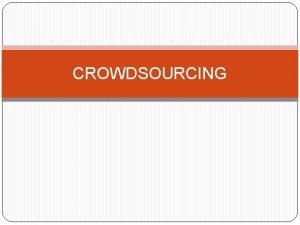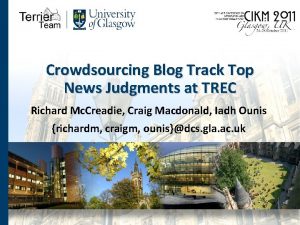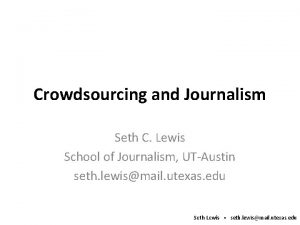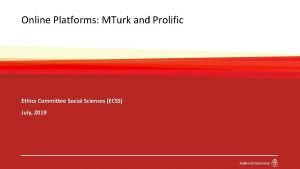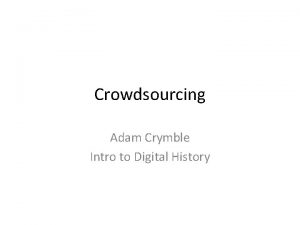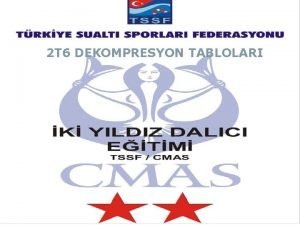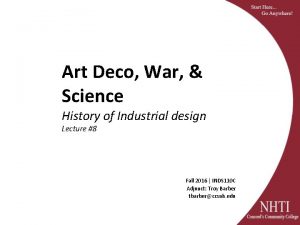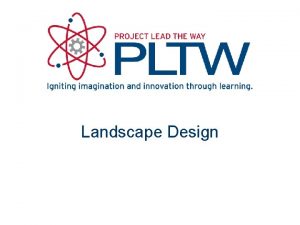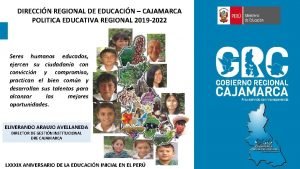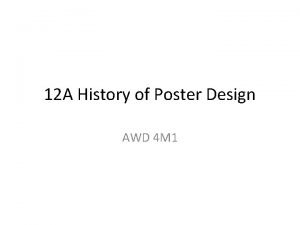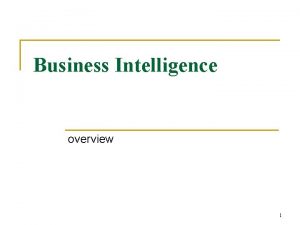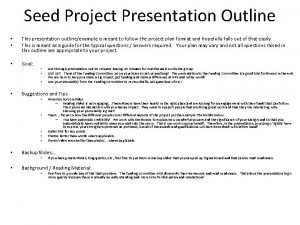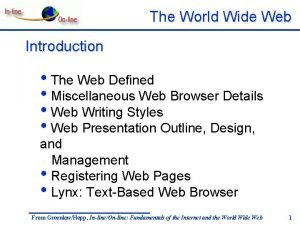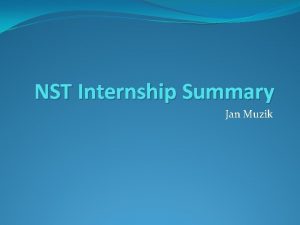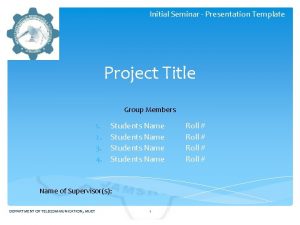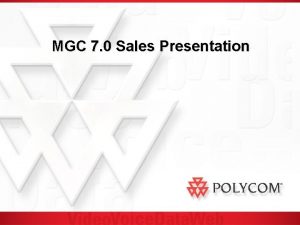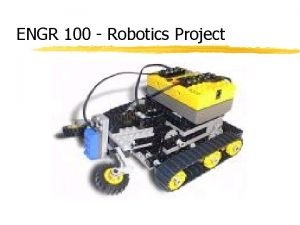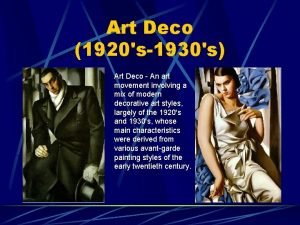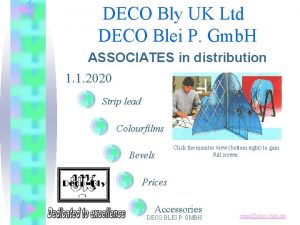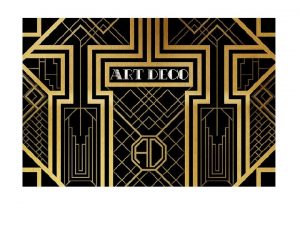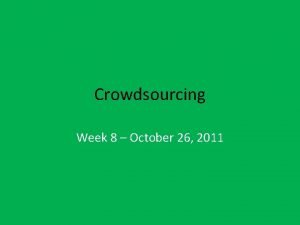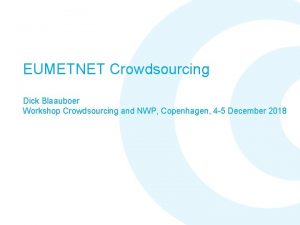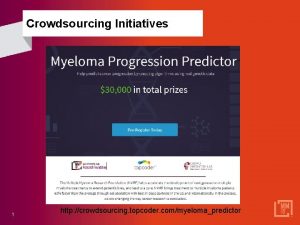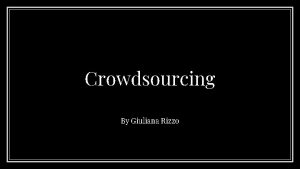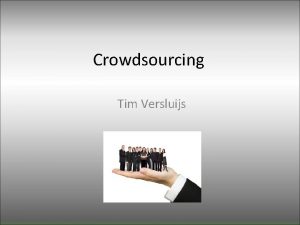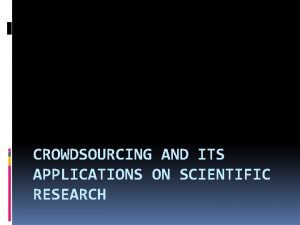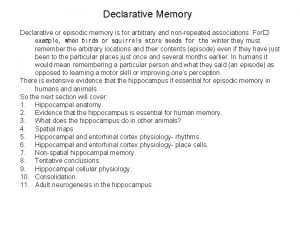Deco Declarative Crowdsourcing Litian Ma Presentation Outline Overview






















![Experiment Setup County(name, [language], [capital]) Experiment Setup County(name, [language], [capital])](https://slidetodoc.com/presentation_image_h/0db8ce99ec05a10dcde054fb1e0772a0/image-23.jpg)
![Benchmark Query County(name, [language], [capital]) Benchmark Query County(name, [language], [capital])](https://slidetodoc.com/presentation_image_h/0db8ce99ec05a10dcde054fb1e0772a0/image-24.jpg)




- Slides: 28

Deco: Declarative Crowdsourcing Litian Ma

Presentation Outline � Overview � Running Examples � Data Model � Query Language � Query Processing � System Architecture � Experiments

Overview � Conventional data management, incorporate “human computation”. Declarative queries DBMS like thing Web

Main Challenges � Resolve disagreeing human opinions. � How does database system interact with human workers? How to enable usage of external sources in addition to crowd? � Right data model and query language. � Materialization � Efficient of crowdsourced data. query processor.

Running Example � Restaurant(name, � Add. Info(address, rating, cuisine) city, zip)

Data Model Schema designer relations and other stuff End user relations Conceptual Schema automatic (system) Raw Schema DBMS

Conceptual Schema � Relations ◦ Like Restaurant and Addr. Info. � Partitioning of attributes in conceptual relation ◦ Anchor attributes (Identifier). ◦ Dependent attribute-groups (Property). � Fetch rules ◦ How to obtain data from external sources including humans. � Resolution rules ◦ Reconcile inconsistent or uncertain values.

Raw Schema � Tables � For actually stored in DBMS. each relation R in the conceptual schema: ◦ One anchor table whose attributes are the anchor attributes of R ◦ One dependent table for each dependent attributegroup D in R, containing the attributes in the resolution rule for D.

• Fetch-Resolve-Join Sequence is a logical concept. • May interleave. • No materialization for conceptual data. Component of Data Model

Conceptual Relations - Restaurant � Restaurant(name, address, rating, cuisine) � Addr. Info(address, city, zip) Enclose dependent attribute-groups � Restaurant(name, address, [rating], [cuisine]) � Addr. Info(address, [city, zip])

Resolution Rules �

Resolution Rules

Fetch Rules �

Fetch Rules Verification

Raw Schema � Recap: ◦ One anchor table ◦ One dependent table for each dependent attributegroup. Rest. A(name, address) Rest. D 1(name, address, rating) Rest. D 2(name, cuisine) Addr. A(address) Addr. D 1(address, city, zip)

Valid Instance � Starting with the current contents of the raw tables and logically performing: ◦ Fetch: add tuples to Deco tables. ◦ Resolve: resolve dependent attributes. ◦ Join: full outerjoin of Deco tables for each relation. � Resulting in a set of data for the conceptual relations. � Logical steps, not necessarily perform, not necessarily in order.

Metadata � Extra column in the raw tables. � Not first-class of data model, but crucial for some crowdsourcing applications. � Deal with messy aspects of using crowdsourced data. � Examples: ◦ ◦ ◦ Data expiration Worker quality Voting Confidence scores Etc.

Query Language �A Deco query Q is a relational query over the conceptual relations. The answer to Q is the result of evaluating Q over some valid instance of the database. Empty! At. Least 5 At least 5 tuples of non-NULL attributes will return.

Query Processing � Push-Pull Hybrid Execution Model ◦ Incremental Push �Borrow ideas from incremental view maintenance. �Result of a fetch rule -> update to one/more base tables -> propagated to view (conceptual table). ◦ Asynchronous Pull �Borrow ideas from asynchronous iteration. �Initiate multiple new fetches in parallel and feed more tuples back to plan ASAP. ◦ Two Phase �Materialization: try to answer using raw tables. �Accretion: Issues fetch rules to obtain more results.

Query Plans

Query Plans

System Design
![Experiment Setup Countyname language capital Experiment Setup County(name, [language], [capital])](https://slidetodoc.com/presentation_image_h/0db8ce99ec05a10dcde054fb1e0772a0/image-23.jpg)
Experiment Setup County(name, [language], [capital])
![Benchmark Query Countyname language capital Benchmark Query County(name, [language], [capital])](https://slidetodoc.com/presentation_image_h/0db8ce99ec05a10dcde054fb1e0772a0/image-24.jpg)
Benchmark Query County(name, [language], [capital])

Experiment 1 - Fetch Configurations

Experiment 2 – Query Plans � Plan “Down” � Plan “Up” ◦ Push all predicates down as much as possible ◦ Similar to reverse fetch query plan. ◦ Predicate pull-up transformation. ◦ Similar to filter later query plan.

Experiment 2 – Query Plans

Thanks!
 Crowdsourcing adalah
Crowdsourcing adalah Crowdsourcing
Crowdsourcing Crowdsourcing journalism
Crowdsourcing journalism Prolific vs mturk
Prolific vs mturk Captcha
Captcha Renaissance floral design history
Renaissance floral design history Dekompresyon tablosu
Dekompresyon tablosu Floral design timeline
Floral design timeline Art deco philosophy
Art deco philosophy Art deco industrial design
Art deco industrial design Art deco landscaping
Art deco landscaping Estrategias deco
Estrategias deco Lpetati
Lpetati Deco
Deco Art resource
Art resource Art deco adjectives
Art deco adjectives Business intelligence overview presentation
Business intelligence overview presentation Topic sentence sandwich
Topic sentence sandwich Us bank developer portal
Us bank developer portal Presentation outline slide
Presentation outline slide Project presentation outline
Project presentation outline Outline of presentation
Outline of presentation Lynx browser
Lynx browser Nst internship
Nst internship Seminar presentation outline
Seminar presentation outline Training presentation outline
Training presentation outline Mgckey
Mgckey Project presentation outline
Project presentation outline Imperative declarative interrogative exclamatory
Imperative declarative interrogative exclamatory
